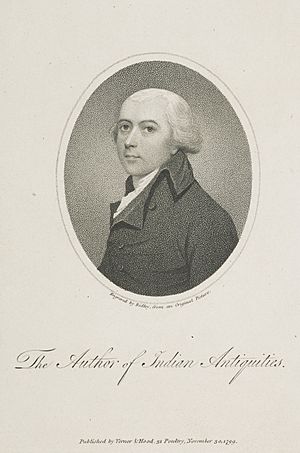Thomas Maurice facts for kids
Quick facts for kids
Thomas Maurice
|
|
|---|---|
 |
|
| Born | 25 September 1754 Hertford |
| Died | 30 March 1824 |
| Alma mater | |
| Occupation | Historian, librarian, orientalist, museologist |
| Employer | |
Thomas Maurice (born 1754, died March 30, 1824) was an important British scholar and historian. He was especially known for his deep studies of Eastern cultures, particularly India. He worked as a librarian at the British Museum and wrote many books about the history and ancient cultures of India.
Contents
About Thomas Maurice
Thomas Maurice was born in Hertford, England, around 1755. His father was a school headmaster. After his father passed away, his family faced financial difficulties. Young Thomas's education was a bit rocky at first.
Early Life and Education
Luckily, a kind teacher named Samuel Parr helped him. Dr. Parr allowed Thomas to attend his school in Stanmore and treated him very well. Thomas was planning to become a church leader. At 19, he went to St John's College, Oxford, and then to University College, Oxford.
After finishing his studies, he became a priest. He worked in a large church parish in Woodford, Essex. Later, in 1785, he moved to a smaller church in Epping, Essex. This move gave him more free time to study.
His Work on India
At University College, his tutor, William Scott, 1st Baron Stowell, encouraged his interest in history. Thomas Maurice then started focusing on the history of India. In 1790, he suggested writing a book about India to the East India Company.
He was worried about the ideas from the French Revolution. So, he changed his first book to include more about Hindu mythology. In 1791, he published the first two volumes of his book, Indian Antiquities. The rest of the volumes came out over time, with the last one in 1797. This book is still a useful resource today.
While working on Indian Antiquities, he also started writing a History of Hindostan. He published three volumes of this work between 1795 and 1799. A second edition was printed in 1821.
Later Life and Career
In 1798, a nobleman named Earl Spencer gave him a church position in Wormleighton, Warwickshire. The next year, he became an assistant librarian at the British Museum. This was a very important job, helping to look after old books and documents.
In 1800, he received a pension, which was a regular payment, that used to belong to the famous poet William Cowper. In 1804, he received another church position in Cudham, Kent.
He continued writing about Eastern history. His Modern History of Hindostan came out in two volumes in 1802 and 1804. He also wrote other books about Eastern history and religion. One of his last big projects was his Memoirs, which shared the story of Indian literature and stories about writers in Britain. These three volumes were published between 1819 and 1822. Thomas Maurice passed away on March 30, 1824.
His Writings
Thomas Maurice wrote several poems and historical works. Here are some of his notable publications:
- 1775 – The School-Boy, a Poem.
- 1777 – A Monody, sacred to the Memory of Elizabeth, Dutchess of Northumberland.
- 1778 – The Oxonian. A Poem.
- 1779 – Hinda; an Eastern Elegy.
- 1784 – Westminster Abbey: an Elegiac Poem.
- 1795 – An Elegiac and Historical Poem, sacred to the Memory and Virtues of the Honourable Sir William Jones.
- 1806 – Verses, being an Apology for the Errors and Eccentricities of Genius.

